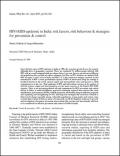Publications - Released in 2005
Since the first report of HIV infection in India in 1986, the virus has spread all over the country although there is geographic variation. There are estimated 5.1 million people infected with HIV with an overall estimated adult prevalence below 1 per cent. Surveys carried out in different sub-populations have yielded prevalence estimates, but data on HIV incidence are limited. Both HIV serotypes 1 and 2 exist in India and HIV-1 C is the commonest subtype reported. Sexual transmission of HIV is most predominant. Spread of HIV in intravenous drug use settings is localized mostly in the north eastern region and metropolitan cities and parent to child transmission is on the rise. Dual epidemics of HIV and tuberculosis, increase in the number of infected women, stigma and discrimination are the main concerns in the Indian HIV/AIDS scenario.
There is an increasing political will and commitment for HIV prevention and control efforts in India. A multi-disciplinary approach combining targeted interventions like early identification and treatment of STDs, condom promotion, blood safety, drug de-addiction programs and expanding and strengthening VCTCs and long-term strategies like awareness oriented to behavioural change especially among vulnerable populations, young people and women, steps towards improvement of literacy, status of women and overall development, reduction in poverty and development of primary prevention interventions like vaccines and microbicides will have to be considered for effective prevention and control of AIDS in India.






